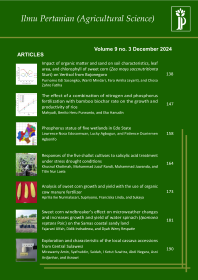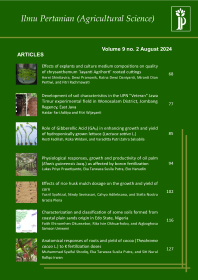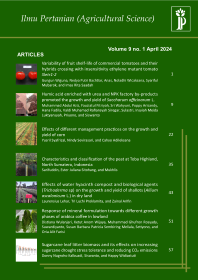Effects of Pyraclostrobin on Growth and Yield of Curly Red Chili (Capsicum Annum L.)
Arizal Nur Hardiansyah(1*), Endang Sulistyaningsih(2), Eka Tarwaca Susila Putra(3)
(1) Department of Agronomy, Faculty of Agriculture, Universitas Gadjah Mada
(2) Department of Agronomy, Faculty of Agriculture, Universitas Gadjah Mada
(3) Department of Agronomy, Faculty of Agriculture, Universitas Gadjah Mada
(*) Corresponding Author
Abstract
Keywords
Full Text:
PDFReferences
Amin, A. W. B., Kuswanto dan A. Soegianto. 2013. Respon Lima Varietas Jagung (Zea mays L.) Pada Aplikasi Pyraclostrobin. Jurnal Produksi Tanaman, 1(1): 80-86.
Badan Pusat Statistik. 2013. Statistik Pertanian Hortikultura. [online] Available at: <http://www.bps.go.id> [Accessed 14 September 2014].
BASF. 2010. Intrinsic Brand Fungicides Plant Health Research. [online] Available at : <http://betterturf.basf.us/products/related-documents/basf-intrinsic-plant-health-research> pdf. [Accessed 25 October 2016].
Conrath, U., G. Amoroso, H. Köhle, and D. F. Sultemeyer. 2004. Non-Invasive Online Detection of Nitric Oxide from Plants and Other Organisms by Mass Spectroscopy. Plant J., 38: 1015-1022.
Ekinci, D. and M. Şentürk. 2010. Interactions of Fungicides and Pesticides with Specific Enzymes. [online] Intech. Available at : https://www.intechopen.com/books/fungicides/interactions-of-fungicides-and-pesticides-with-specific-enzymes [Accessed 11 November 2016].
Kanungo, M and J. Joshi. 2014. Impact of Pyraclostrobin (F500) on Crop Plants. Plant Science, 1(3): 174-178.
Khan, H. Z., S. Iqbal, N. Akbar, and D. L. Jones. 2011. Response of Maize (Zea mays L.) Varieties to Different Levels of Nitrogen. Crop and Environment, 2(2): 15-19.
Köehle, H., K. Grossmann, T. Jabs, M. Gerhard, W. Kaiser, W., J. Glaab, U. Conrath, K. Seehaus, and S. Herms. 2003. Physiological Effects of the Strobilurin Fungicide F 500 on Plants. In: H. W. Dehne, U. Gisi, K. H. Juck, P. E. Russel and H. Lyr , Eds., Modern Fungicides and Antifungal Compounds III, Bonn, Germany: Agroconcept GmbH.
Kuswanto dan K. P. Wicaksono. 2011. Pyraclostrobin Effect For Nitrogen Fertilizer Efficiency On Corn (Zea mays). Report research Universitas Brawijaya [online] Available at: http://kuswanto.lecture.ub.ac.id/files/2012/02/Report-2011-Pyraclostrobin-Effect-for-Nitrogen-Fertilizer-Efficiency-on-Corn.pdf [Accessed 11 November 2016].
Kyveryga, P. M., T. M. Blackmer and D. S Mueller. 2013. When Do Foliar Pyraclostrobin Fungicide Applications Produce Profitable Soybean Yield Responses. [online]. Plant Health Progress. Available at: https://www.plantmanagementnetwork.org/php/elements/sum2.aspx?id=10699 [Accessed 11 November 2016].
Monsanto. 2012. Evaluation of Soybean seed treatment in the Mid-South, Technology Development and Agronomy. [pdf] Mississipi: Demonstration Report Learning Center at Scott. Available at: https://monsanto.com/app/uploads/2017/05/slc-ag-soybean-seed-treatment.pdf [Accessed 10 November 2016].
Nurfalach, D.R. 2010. Budidaya Tanaman Cabai Merah (Capsicum annum L.) Di UPTD Perbibitan Tanaman Hortikultura Desa Pakopen Kecamatan Bandungan Kabupaten Semarang. Tugas Akhir. Universitas Sebelas Maret.
Ribeiro, W. R. M., L. P. Pacheco, F. P. Monteiro, F. A. Petter, W. L. de Carvalho, T. O. Sousa, A. V. S. Gualberto, and F. A. Neto. 2014. Fungicides phytotonic action on the development of soybean. African Journal of Agricultural Research, 9: 3283-3290.
Venancio, W.S., M. A. T. Rodrigues, E. Begliomini and N.L. de Souza. 2003. Physiological Effects of Strobilurin Fungicides on Plants. Publ. UEPG Ci. Exatas Terra, Ci. Agr. Eng., Ponta Grossa, 9: 59-68.
Yusria, F. I. 2015. Pengaruh Dosis Pyraclostrobin Terhadap Gugur Bunga dan Layu Pentil Dua Klon Kakao (Theobroma cacao L.) Asal Embrio Somatik. Skripsi. Universitas Gadjah Mada.
Zhang, Y. J., X. Zhang, C. J. Chen, M. G. Zhou, and H. C. Wang. 2010. Effects of Fungicides JS399-19, Azoxystrobin, Tebuconazloe, and Carbendazim on the Physiological and Biochemical Indices and Grain Yield of Winter Wheat. Pesticide Biochemistry and Physiology, 98: 151-157.
Article Metrics
Refbacks
- There are currently no refbacks.
Ilmu Pertanian (Agricultural Science) ISSN 0126-4214 (print), ISSN 2527-7162 (online) is published by Faculty of Agriculture Universitas Gadjah Mada collaboration with Perhimpunan Sarjana Pertanian Indonesia (PISPI) and licensed under a Creative Commons Attribution-ShareAlike 4.0 International License.













